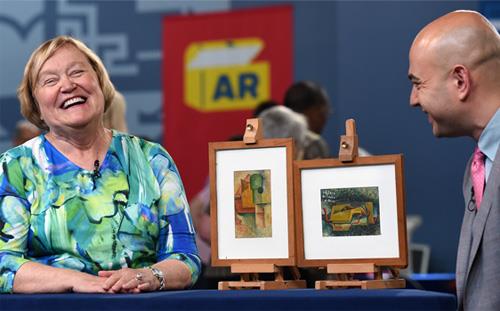
In her 2009 book, Antiques Roadshow Behind the Scenes, the program’s executive producer for the last two decades, Marsha Bemko, describes how the Antiques Roadshow (ARS) entourage rolls into a town, executes a well-practiced but still-complex setup, instructs its many local volunteers about their roles and, by the time the doors open and ticket holders enter the next day, up to 300 people have gone from prep to air-ready start in a remarkably efficient way.
It easily could be said Bemko and company hit the ground running.
The 24th season of the popular PBS series debuts Jan. 6. Later that month, during a visit to this season's second stop, West Fargo, N.D., a guest getting a watch appraisal also hits the ground — but not running; from a standstill. The appraisal exceeded his dreams, it seems, and falling was his body's shocked reaction. In order not to ruin any viewer's fun, no spoiler here — except that Ms. Bemko said the drop to the ground was a memorable first.
So memorable, in fact, that the footage has supplanted the 2007 Andy Warhol "soup can" appraisal she had shown for years to venue volunteers the night before the event at a reception she calls "Rah-Rah Roadshow."
An executive producer's ability to fire up those who make the season's 15 annual episodes sparkle is an important factor. But simply "rah-rah" hasn't made it possible for this series to attract 8 million viewers each week over so many seasons. The Fargo watch appraisal is another example of the unscripted and unpredictable magic that keeps those millions tuning in. But she believes the popularity would not last unless the series is kept fresh. That's why, when the watch owner hit the ground, he didn't do so on a convention-center floor. This will be the third season that ARS has replaced large-hall settings for more diverse, usually a bit opulent and — when possible — outdoor settings.
Ms. Bemko said that even though these venues are more challenging than places where a roof, climate control, and loading docks were a given, making the site an additional reason to watch "adds another level of energy" to the series. "Each venue is so different . . . we learn as we go."
Weather now can be one of the new challenges, with each location having "a sunny-day plan and a rainy-day plan," she said. That plan requires making detailed CAD site-use drawings of the properties for each possibility and switching, quickly, if necessary. When the show visited Louisville's Churchill Downs, some appraisals were done in horse stalls — though weather-protected, these weren't really popular with some of the appraisers who ended up in the not-too-fragrant settings, she shared.
Several seasons back, ARS dropped the segments in which visits were made to a local museum or other historic location where a show expert would talk about some of the valuable items housed there.
Intricate ratings information, Ms. Bemko said, showed those were the times when viewers left the room for either relief and/or refreshment. The outings have been replaced with short inserts about points of interest in the visited location. Another recent addition has been brief appraisals, or "snapshots," in which all the relevant item information is quickly summed up, making it possible to share more items per show.
The format also has changed this year by replacing a host with a voice-over announcer — again, increasing the time spent on appraisals.
Each year's city visits begin in April and end about three months later. Then the editing begins in which so much accumulated material is reduced to fit into the hour-long show. It's a process Ms. Bemko and her producers revisit and revise almost endlessly, hoping for something as close to perfect as possible.
Still, she admitted, when she watches the final edit as it airs on PBS, "I’m still editing it in my head."
Another Roadshow twist this year is a separate half-hour offspring called Antiques Roadshow Recut. The Friday-night compilation of special appraisals from previous shows will premiere Jan. 3 (check local listings) on PBS.
Though the list of places that will show up on Season 25 hasn't been finalized yet, here are the places viewers will see this year and the dates on which they'll be broadcast (check local listings):
Jan. 6, 13, 20: Winterthur Museum, Garden and Library, Winterthur, Del.
Jan. 27, Feb. 3, 10: Bonanzaville pioneer town, West Fargo, N.D.
Feb. 17, 24, March 16: Crocker Art Museum, Sacramento, Calif.
March 23, 30, April 13: Desert Botanical Garden, Phoenix, Ariz.
April 20, 27, May 4: McNay Art Museum, San Antonio, Texas